Travel consultant Sue Beechey travelled to Patagonia with Viva and Chimu, and here she tells us all about her experience in this spectacular part of the world.
The flight to Santiago from Auckland was 11 hours, followed by a 7 1/2 hour transit in Santiago before our connecting flight to Buenos Aires. Instead of just staying at the airport we were collected by the Viva and Chimu local operations and taken to a wonderful Chilean restaurant for lunch, The Liguria Bar and Restaurant, which I can highly recommend. After we had a short walking tour of the area which had lots of quirky street art.
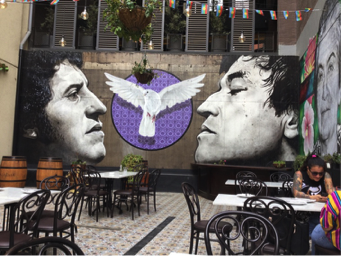
Buenos Aires
What an interesting and vibrant city! We enjoyed two nights and one full day here and wished it could have been longer to really appreciate all there is to see.
We had a guided tour with a really knowledgeable guide Marina who worked with Viva and Chimu. The tour she took us on included the Recoleta cemetery with the grave of Eva Peron. The visit was really interesting and we heard many stories of the different inhabitants. As we were departing, a funeral entourage arrived along with a funeral car – evidence that this cemetery is still being used today.
We passed tango dancers, visited a market in the up and coming arty St Elmo area, and visited the Plaza de Mayo (the main square of Buenos Aires where the Federal Government Office and the Cathedral is located). It was interesting to absorb the atmosphere, people watch and observe the Changing of the Guards at the cathedral.
We were treated to lunch and experience Argentinean cooking at Fernando Mayoral, who previously ran a 3 Michelin starred restaurant. He now offers a private experience demonstrating his cooking, and we of course got to eat his mouth-watering dishes which featured delicious BBQ meats. A popular alternative is the ‘Argentine Experience’ which is more hands on where you learn to make the traditional empanadas (mini savoury pies) as well as other Argentinian dishes.
Tierra del Fuego National Park
We were taken on a six hour excursion into the Tierra del Fuego National Park, which lies 12km east of Ushuaia. Trekking in the park was beautiful with the snowy scenery but was muddy underfoot and you definitely needed hiking boots. We saw some of the birdlife that inhabit the area and also some evidence of the damage caused by beavers (introduced from Canada in the hope they would be able to get a fur trade).
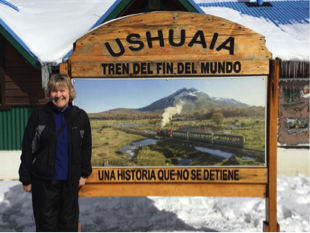
We were given a lovely lunch in special igloo tent. Afterwards we were taken back to the operations office where we could use some wifi (our last for the next five days!)
We had drinks at the Ramos Generales Bar, Ushuaia prior to boarding our ship. It’s a cute bar which also offers beer tasting to have a taster of the local craft beers. We then embarked on a four night Patagonian Explorer cruise from Ushuaia to Punta Arenas.
Cruising from Ushuaia to Punta Arenas
This cruise was the highlight of the trip and a great way to view the stunning scenery at the “uttermost end of the earth”. We sailed through the Strait of Magellan, Cape Horn and the islands of Tierra del Fuego, visiting places which only see around 1,000 people each year. We got to see beautiful glaciers, landscape, lighthouses and penguin colonies, and learn about the fascinating history of this area.
What are the cruise ships like?
There are two ships, the M/V Stella Australis ship and her sister ship, the M/V Ventus Australis, that were specially built in Chile to cruise this area. There are 100 ocean view cabins which can accommodate 210 passengers.
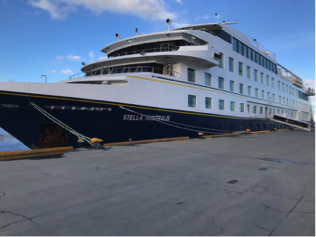
The cruise offers three one-way itineraries between Ushuaia and Punta Arenas of three, four nights or seven nights return. The cruise season runs from September to April.
The cruises are fully inclusive of meals, have an open bar and offer all excursions via Zodiacs with outstanding guides trained in Glaciology and Natural History. There are no wet landings as the crew transport a metal gang plank ahead of the first zodiac landing. The crew are well trained and my initial nerves about getting on and off the zodiac were quickly dispersed in their safe hands.
The ship was much more comfortable than I imagined it would be with functional comfortable cabins and lovely lounge areas. The passengers on our cruise were from 14 different nationalities and even included 11 children, some were very young children including a Swiss couple with an 18 month old.
Cape Horn National Park
We caught zodiacs to the Cape Horn National Park. We were lucky to be able to get off as the last three cruises had to pull out of this trip due to the safety of the passengers. The weather was snowing and high winds and then calm with sunshine, which was just amazing.
We made our way to the Cape Horn Monument, an albatross sculpture and then the outside of the lighthouse. Amazingly a lighthouse keeper and his family with children live here. We sadly didn’t get time to go inside the lighthouse and meet the family as the ship horn had sounded to get us back on board due to the change in the weather.
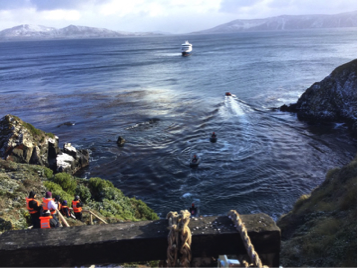
After lunch we had a bridge tour and at around 4pm the afternoon excursions at Wulaia Bay commenced. The departure times varied depending on the level of difficulty of the excursion chosen. I chose the easiest option only because this one had more talks on the Yagan People (also known as the Yamana People) who are the original indigenous people of this part of the world. I found their history fascinating. They are a tribe of people who did everything by the water and naked.
The day we arrived in spring it was zero degrees and with the wind chill this felt freezing cold. It was so fascinating to learn about these people and their harsh living conditions. We popped into an old radio station building which is now used as a museum to honour the Yagan/Yamana people. There you’ll also find a wooden mail barrel where you post letters or postcards meant to be hand delivered by future travellers – an ancient mariner tradition revived by Stella Australis. I found a post card for a family in Hoon Hay Christchurch which I faithfully hand delivered.
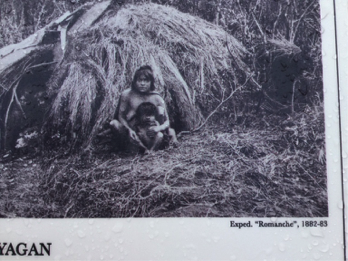
Glacial encounters
The following day it was all about glaciers as we sailed through the Beagle Channel, firstly to the Pia Glacier and then to the Garibaldi Glacier. The first was accessed by Zodiac and then a 15 min walk alongside the glacier or climbing up to a couple of lookout points to view the glacier (by far the best option). Upon our return to the Zodiac departure point, we were greeted by the staff handing out hot chocolate with a shot of whiskey – very welcome and very yummy. The second glacier was not suited to a landing the day we were there so the ship hung around in the bay in front of the glacier and allowed the passengers to snap away on their cameras.
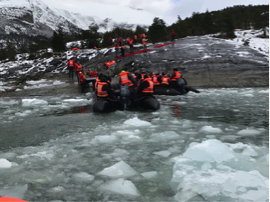
Next we visited two more glaciers. We caught the zodiacs to the shore and walked to the Aguila Glacier which was stunning. An adventurous German pilot from years gone by who had navigated many areas of the world thought this the most beautiful place he had ever seen on earth – something I found easy to believe.
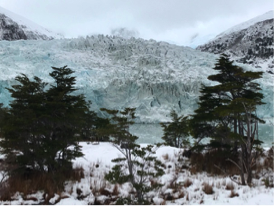
Whilst we were there we spotted a fox hunting for food on the shoreline that did not seem the least bit afraid of us humans. We took many photos and also walked in the nearby forest. After a tour of the engine rooms we later had our second excursion which was to Condor Glacier. This was by Zodiac only with no landing. Sadly no condors for us. We were very lucky, however to witness a dramatic calving of the glacier into the water.
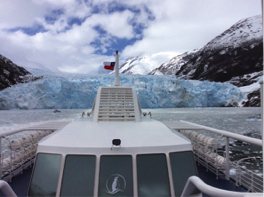
On our final night we had a farewell dinner after a viewing some of the passengers’ own photos on a screen. We then visited Magdalena Island with its lighthouse and Magellanic penguins. The males had landed and were preparing their old nesting sites in preparation for the return of their female breeding partner. There was lots of calling out to their penguin partners. The penguins walked right past us (some with nesting materials in their beaks). They were fascinating to watch as they greeted each other and had no fear of humans. This excursion is replaced with a visit to Marta Island to see the South American sea lions during September and April when the penguins dwell elsewhere.
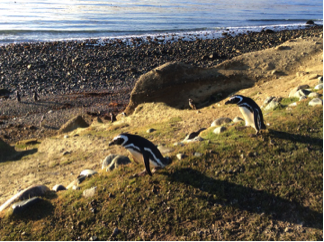
Torres del Paine National Park
Upon clearing immigration at Punta Arenas we were met for our five hour transfer to the Las Torres National Park. An en route lunch was included at the original Estancia owned by the family who built the Hotel Las Torres. We had BBQ lamb followed by a sheep shearing demonstration and also a tour of the original estancia/house which is kept as a museum.
You cannot beat the location of the Hotel Las Torres for exploring the Torres del Paine National Park. The tours and hikes were excellent. I did an intermediate horse trek on the first day which I loved. They advised this trek was suitable for beginners. I have been on a horse just a couple of times previously but felt fully comfortable with the trek and the instructions.
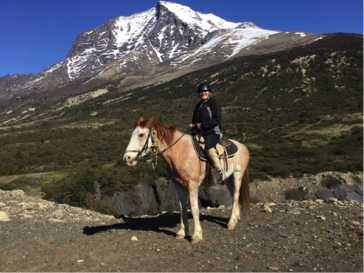
We also did an afternoon tour to Los Cuenos (the horns of Patagonia) which consisted of a 40 minute drive and then two hours of easy walking to view the lakes and mountains and the waterfalls.
On our second day we did a full day Cerro Paine trek. The first part was a two hour horseback ride through the forest and then a three hour hard tramp up the very windy Cerro Paine Mountain which gives you a beautiful view of the Las Torres. Our guide thought this was the best view of the Torres/Towers and the trek a better option than the Torres trek which he said was also harder and the track dangerous. The wind made this hard track even harder and we really felt the force of nature up here. The hotel provided a good packed lunch which we ate next to a big rock just to get some shelter from the horrendous wind. The guides on each tour were excellent and gave good clear instructions.
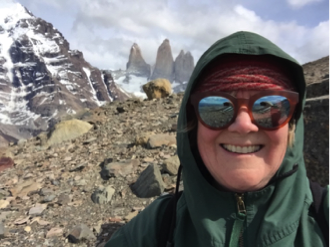
Some helpful hints for travel to Patagonia
- If you have a stopover en route to Patagonia take suitable light clothing as temperatures are a lot warmer in Santiago and Buenos Aires.
- Take a brolly to Buenos Aires. Spring is the rainiest season followed by Summer. Winter is the driest. The seasons are the same months as NZ.
- Change your Argentinian pesos before leaving the country. US$ cash is a good currency to take to get more value for your money.
- ATMs have high fees and often run out of currency.
- Do a guided city tour to learn about the changing history of Buenos Aires.
- Take suitable clothing to Patagonia. Waterproof clothing is essential. Winds can reach 180 kph and are more persistent in the summer. Snow can fall even in the summer.
- Take tramping boots, a waterproof jacket and pants and gloves, a warm hat, warm layers including thermals, sun glasses and a walking pole (both the ship and the hotel have a limited supply but good to take your own as they frequently run out).
- Your skin gets very dry so a good moisturiser and lip salve will come in handy.
- Take a travel Adapter with a 2 or 3 round pin 220 volt plug.
- Bring sea sickness tablets with you – I was grateful to have sea legs when sailing to Cape Horn.
- Binoculars can come in useful for wildlife watching.
- A normal suitcase on wheels is fine to take on the ship. I found that by opening out the suitcase, the two halves fitted under the bed ok.
- Take packing inserts as these double up to drawers. This is especially handy in the cabin as the one small wardrobe was kept as a wet area for outside clothing.
Interested in planning your own trip to Patagonia? Talk to the team at World Travellers Riccarton about how we can help you have an adventure like Sue’s!

